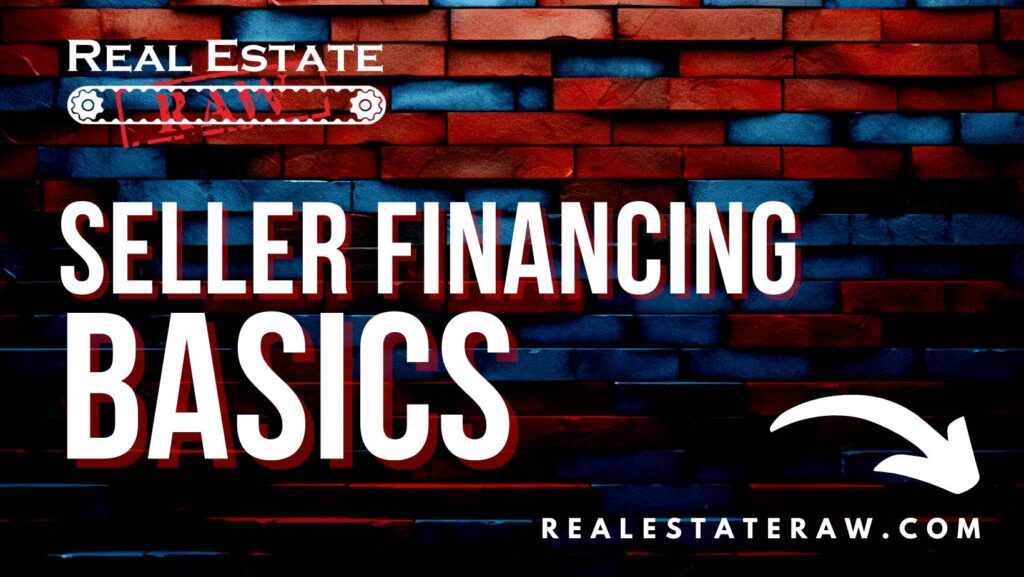Seller financing is my favorite form of creative financing. Seller financing is just what it sounds like. The seller or owner of a property will finance the deal for you, just like a bank or traditional lender. This means that you will need to impress the seller enough for them to give you the financing, but you won’t need to qualify with a traditional lender.
If a seller is openly advertising seller financing, be careful. The property is likely in unbelievably bad shape. Don’t immediately discount a deal if it is advertised with financing available but do expect a fair amount of distress. In my best seller financing deals, I had to convince the seller to carry back financing. These were the deals that were distressed, but not terribly so.
Once you have analyzed the deal, you will be ready to make an offer for seller financing. If the seller accepts this offer, you will need to verify that the seller has the equity in the deal to be able to give you the financing. This is one of the drawbacks to seller financing. If the seller has a mortgage on the property, then they cannot finance it to you, and you will not be able to take true possession of the title. If you find the seller has a mortgage, a Master Lease Option may be a better way to go.
Price vs. Terms
You should always try to get the best price for any property that you are trying to buy (goes without saying), but most buyers and sellers tend to focus too heavily on price. Sellers also tend to be more sensitive to the overall price that they are getting for a property and less focused on the terms of the financing.
Price makes a big difference when it comes to exit strategies, and you should never pay too much, but the terms of the loan you get will make or break the operations of the deal while you have it. The terms of the loan include:
1. Term (length of the loan)
2. Interest rate
3. Down payment
4. Amortization schedule
As I have discussed already, you need to solve problems and bring value when seeking CSF. If a seller is going to provide you with financing, then you need to be prepared to give a higher sales price.
How to Give on the Price and Take on the Terms
In many cases, I have given the seller most or all the asking price when they were willing to carry back financing. My rule of thumb is the more distress a deal has, the easier it is to get into it. If a seller has a distressed asset and wants a high sales price and I must get a mortgage and qualify for a loan, then I am not likely to be interested. If a seller has a distressed asset and they are willing to help me solve their problems, then I am interested! You should not have to jump through too many hoops to help someone solve their problems.
In the fall of 2015, I bought one of the best deals I have ever seen. A portfolio of 196 apartments in middle Georgia, consisting of 3 smaller properties ($26,531 per door). The asset was in fine shape physically but had low occupancy due to the seller’s personal neglect.
Due to the low occupancy, I was only able to get a high interest rate, short term loan from a commercial lender. The monthly payments to the bank were going to kill the deal for me. The property wasn’t producing enough cash to cover the note.
The solution was that I got the seller to carry back a second mortgage for a 0 percent interest rate. This effectively reduced the amount of money I needed to borrow from the lender and made the deal work. The seller got the overall price that he wanted but had to help me on terms to get the deal done. Give on price, take on terms.
If you are going to be paying more for a property, then you need to be overly aggressive with the terms of the seller financing. You need this property to cash flow on a monthly and annual basis, regardless of what you pay for it. Keep in mind that seller financing does not have to be 100 percent of the loan. Sometimes a seller can assist with the down payment money by taking back a second mortgage. Here are some things to consider when structuring the loan.
Interest-Only Payments
If a deal does not have good cash flow at the start, try negotiating interest-only payments. This will allow you to keep more of the rental income to service the property and to allow for cash flow. You can even offer to make interest and principal payments at a point when the deal makes more money.
The ideal for an interest-only (IO) loan is when the monthly payment will be much less than if you were paying principal and interest. The lower monthly payment will allow you to produce more cash flow while maintaining the same amount of rent due. This will allow you to spend the cash flow to stabilize the asset.
Defer All Interest and Payments to the End of the Loan
If a property needs major renovations, then defer all or some of the payments to the end of the loan. If the seller wants to start getting a check at a point during the loan, you may also try to get them to defer the payments during the repositioning of the property.
For example, if you decide that a property needs X amount of repairs and that will take X amount of time to complete, then tell the seller that the payments for those months will be added to the purchase price and paid at the end of the loan. This will allow you to complete the needed repairs while the property is not cash flowing. It is particularly important that you do not over-encumber a property with added expenses as you are bringing it back to life. If a seller doesn’t see it that way and must be paid even when the deal doesn’t make money, that may not be the right deal for you. Let them deal with it themselves.
Interest Rate
You should not expect to get the market’s most competitive interest rate when you get seller financing. You need to try to get the best interest rate you can negotiate, but you also need to offer an interest rate that will be attractive to the seller.
Keep in mind that it is not unusual to pay 2-3% more in interest than the current lending rates at your local bank. This is not expensive when you consider all the benefits to having the seller finance the deal for you. Whatever interest rate the seller may want, you need to make sure that the interest plus principle (debt service) will allow you to cash flow the property once you have completed the repairs and leased up the units.
A second point on interest rates is that there is a legal minimum to private loan interest rates. This minimum required interest rate is called the Applicable Federal Rate (AFR), and sometimes called the “arm’s length” rate. This is the minimum interest rate that a private lender can give without violating federal law. The law is put in place to prevent people from “gifting” assets to others (usually family) by calling it a loan with a 0% (or incredibly low) interest rate. This would effectively allow someone to transfer wealth while avoiding gift or transfer tax. Therefore, the federal government has created the AFR.
This concerns you if you are getting (or giving) private loans. If you get a loan or seller financing with an interest rate below the AFR, the IRS may consider that a gift and not a loan. The lender may be charged punitive fees and may be charged an income tax. This could have terribly negative consequences for you and your lender. Internal Revenue Code (IRC) Section 7872 governs the AFR, and the rate changes periodically. You need to consult with an accountant and visit the IRS website for updated minimum rates. This will keep you and your lender in compliance with this tax code and help avoid any unnecessary lender surprises.
Down Payment
This is an area where you can get creative. Try to put down as little as possible but just enough to make the seller comfortable with the deal. If a property needs repairs, then follow this one simple rule: Use the down payment to do the repairs.
Decide how much cash it’s going to take to complete the needed renovations to the property. You will decide this during your analysis and inspection period. Instead of giving the seller the down payment directly, use that money to fund the needed repairs. You don’t want to give the seller a cash down payment and then need to have more money to do the repairs.
If the seller does not totally agree with you using the down payment to do the repairs, explain to them that if you were to actually default on the loan and they take possession of the property, it would be in better shape than when they gave it to you. You can also offer to put this down payment into a third-party escrow account. This will allow the seller to see that the money exists and that you do have the cash to do the repairs. You can then draw out the money as the seller approves the work that you are doing. This added level of security will help convince some sellers to give you financing.
Repairs
Once you operate the property, you will likely need to be responsible for the repairs and cost of operations on the property. This is okay because you will be using the income that the property produces to do these repairs. The difference between what the property produces, and the expenses is the cash flow, and you get to keep that!
You will need to be prepared for any larger repair expenses. This is known as capital expenditures or “cap ex.” Budget for this by setting aside a capital expense reserve account. You will be taking a portion of the income of the property and setting it aside to pay for these expenses. I suggest setting up an escrow account outside of your normal operating account for this money. This will keep you from spending savings on normal operations.
A good rule of thumb is to save about $250-$300 for every unit on the property each year. This will create your cap ex reserve account. It is good to get in the habit of doing this for two reasons. One is to help protect against the risk of unbudgeted repair items. Secondly, if you refinance the deal with a bank, they will likely make you set this money aside as part of the loan.
Insurance
If you are going to be the new owner with seller financing, you will likely need to get your own insurance policy. Contact local agents to get the best prices. Make sure that the price is not all that you look at when you get insurance. Cheap insurance tends to not come with much coverage. It’s hard to give a rule of thumb for insurance pricing per unit, as the info changes so quickly. In general, it will be important to talk with insurance agents when you get into analyzing deals.
Tax Benefits
As the new owner of record, you will now receive the tax benefits of the property. This is good for you. If the owner wants to retain the tax benefits, then a Master Lease Option may be a better offer than seller financing. Consult an accountant to discuss your tax strategies before the closing. I suggest you do this during your due diligence period on the property.
Record the Title
This is a tremendously important step in any form of creative financing, especially seller financing. I strongly suggest you have a real estate attorney create the contracts and documents for any creative financing deal. You will be able to find seller financing documents and Master Lease Option contracts online, but you must have your legal counsel review anything before you submit it to the seller.
Next, have an attorney or title company conduct the closing. They will be able to do a property title search to make sure that the seller can convey a clear title to you. It would be a disaster to give the seller a down payment and take possession of a deal, only to find out that they did not tell their business partner (who has ownership) what they were doing. An attorney/title company will clear the title. If any existing liens appear, then you will be notified before you close. I assure you this will be money well spent!
For more articles like this and other information check out my site www.realestateraw.com.
Best of luck!
Bill Ham


































